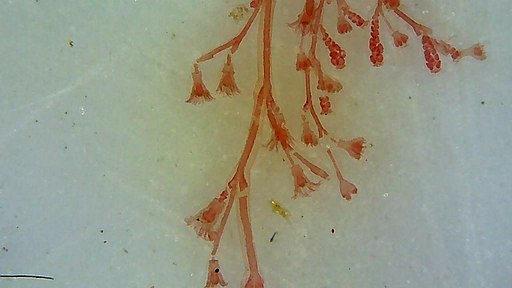Invasion History
First Galapagos Record: 2015General Invasion History:
Obelia oxydentata was described from the US Virgin Islands. It has been confused with many similar species of Obelia and Clytia. Dale Calder, reviewing synonymous records, gives O. oxydentata a range from Chesapeake Bay to Brazil (Calder 2019). It is also known form the Indo-West Pacific, from Madagascar to Fiji and Japan. Aside from a puzzling record from Pacific Panama (Clarke 1907, cited by Calder 2021), the Galapagos and Ecuador records are the first from the Eastern Pacific (Calder 2019; Calder 2021).
Invasion History in the Galapagos:
Obelia oxydentata was first collected in Tortuga Bay, Franklins Bay, and Puerto Ayora, all on Isla Santa Cruz, in April–May 2015, on the bryozoan Amathia verticillata from fouling plates (Calder et al. 2019). In 2018, it was also found in San Cristobal Island. It appears to be common in fouling communities in the Galapagos Islands (Carlton et al. 2021).
Invasion history elsewhere in the world:
Invasion history for Elsewhere in the World has not been summarized for this species at this time.
Description
Obelia oxydentata is a hydozoan belonging to a complex of similar species with sessile hydrozoans and planktonic medusae. It was described from the U.S. Virgin Islands by Stechow in 1914, but has been frequently lumped with O. bidentata, described from Long Island Sound by Clark in 1875. Obelia oxydentata is 1–60 mm tall (more usually 1–10 mm), monosiphonic, and is associated with tropical and subtropical climates, while O. bidentata is polysiphonic, up to 150 mm, and associated with cooler climates (Calder et al. 2019; Calder et al. 2021).
O. oxydentata is irregularly branched and its stem has 4–6 annulations above each pedicel. The margins of hydrothecae have about 101–102 bicuspid teeth. Gonothecae are oblong-oval and produce gonophores, which bud off as medusae (Calder 1971, as O. bicuspidata, Calder et al. 2019).
Obelia spp. medusae are circular and nearly flat, lacking a velum, with 4 radial canals bearing round, numerous tentacles. They are not easily identified to species (Calder 1971).
Taxonomy
Taxonomic Tree
| Kingdom: | Animalia | |
| Phylum: | Cnidaria | |
| Class: | Hydrozoa | |
| Subclass: | Hydroidolina | |
| Order: | Leptothecata | |
| Family: | Campanulariidae | |
| Genus: | Obelia | |
| Species: | oxydentata |
Synonyms
Obelia longicyatha (Fraser 144, cited by Calder 2019, )
Potentially Misidentified Species
Obelia bidentata (Clark 1875), described from Long Island Sound, has been consdiered conspecific with O. oxydentatna, described from the Vrigin Islands by Stechow (1914). O.belia bidentata colonies are polysiphonic, and larger, to 15 cm tall, and associated with cold-termperate climates, while O. oxydentata are smaller (~1 cm tall, and monosiphonic (Calder et al. 2019; Calder et al. 2021).
Ecology
General:
Obelia oxydentata polyps grow from a creeping stolon attached to a hard substrate. The stolons asexually produce buds, which break off as small, swimming medusae. The planktonic medusae feed on zooplankton. Typically, planktonic medusae release eggs and sperm into the water column, which fuse to form ciliated planula larvae. The planula larvae settle on suitable substrates and develop into a hydroid (Barnes 1983).
Food:
Zooplankton, epibenthos
Consumers:
Nudibranchs
Competitors:
other hydroids
Trophic Status:
Suspension feederHabitats
| General Habitat | Marinas & Docks | None |
| General Habitat | Rocky | None |
| General Habitat | Coral reef | None |
| General Habitat | Mangroves | None |
| Salinity Range | Mesohaline | 5-18 PSU |
| Salinity Range | Polyhaline | 18-30 PSU |
| Salinity Range | Euhaline | 30-40 PSU |
| Vertical Habitat | Epibenthic | None |
| Vertical Habitat | Planktonic | None |
Life History
Tolerances and Life History Parameters
| Minimum Salinity (‰) | 7 | Calder 2019 |
| Maximum Salinity (‰) | 37 | Typical Gulf of Mexico salinity |
| Maximum Height (mm) | 60 | Usually 10-20 mm (Calder 2019, Calder et al. 2019; Calder et al. 2021) |
| Broad Temperature Range | None | Warm-Temperate-Tropical |
| Broad Salinity Range | None | Euhaline-Mesohaline |
General Impacts
Obelia hydroids are a common component of shipping and industrial fouling communities (Woods Hole Oceanographic Institution 1952).
Regional Distribution Map
Non-native
Native
Cryptogenic
Failed
Occurrence Map
References
Calder, Dale R. (1971) Hydroids and hydromedusae of southern Chesapeake Bay., Virginia Institute of Marine Science, Special Papers in Marine Science 1: 1-125Calder, Dale R. (2010) Some anthoathecate hydroids and limnopolyps (Cnidaria, Hydrozoa) from the Hawaiian archipelago, Zootaxa 2590: 1-91
Calder, Dale R. (2013) Some shallow-water hydroids (Cnidaria: Hydrozoa) from the central east coast of Florida, USA, Zootaxa 3648: 1-72
Calder, Dale R. (2019) On a collection of hydroids (Cnidaria, Hydrozoa) from the southwest coast of Florida, USA, Zootaxa 4689(1): 1-141
Calder, Dale R. and 8 authors (2021) Additions to the hydroids (Cnidaria, Hydrozoa) of marine fouling communities on the mainland of Ecuador and in the Galapagos Islands, Aquatic Invasions 16: 208-252
Calder, Dale R.; Carlton, James T.; Larson, Kristen; Mallinson, Jenny J.; Choong, Henry H. C.; Keith, Inti; Ruiz, Gregory M. (2019) Hydroids (Cnidaria, Hydrozoa) from marine fouling assemblages in the Galápagos Islands, Ecuador, Aquatic Invaders 14: 21-58
Woods Hole Oceanographic Institution, United States Navy Dept. Bureau of Ships (1952) Marine fouling and its prevention., United States Naval Institute., Washington, D.C.. Pp. 165-206
